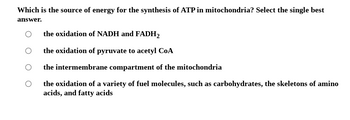
Biochemistry
9th Edition
ISBN: 9781319114671
Author: Lubert Stryer, Jeremy M. Berg, John L. Tymoczko, Gregory J. Gatto Jr.
Publisher: W. H. Freeman
expand_more
expand_more
format_list_bulleted
Question

Transcribed Image Text:Which is the source of energy for the synthesis of ATP in mitochondria? Select the single best
answer.
the oxidation of NADH and FADH2
the oxidation of pyruvate to acetyl CoA
the intermembrane compartment of the mitochondria
the oxidation of a variety of fuel molecules, such as carbohydrates, the skeletons of amino
acids, and fatty acids
Expert Solution
This question has been solved!
Explore an expertly crafted, step-by-step solution for a thorough understanding of key concepts.
This is a popular solution
Trending nowThis is a popular solution!
Step by stepSolved in 2 steps

Knowledge Booster
Similar questions
- What happens during the first stage of glycolysis? Group of answer choices FADH2 is produced 4 ATPs are produced 2 ATPs are invested Oxygen is usedarrow_forwardWhich of the following is false concerning ATP? A The first and second phosphate bonds contain a lot of energy used to power cellular functions. It contains lots of potential energy. Is made by bonding ADP with a phosphate during cellular respiration. D) Requires the actions of enzymes.arrow_forwardWhich compartment of the eukaryotic mitochondrion is responsible for the formation of NADH, and FADH2, during catabolism of pyruvate into carbon dioxide? the mitochondrial matrix the outer mitochondrial membrane the intermembrane space the inner mitochondrial membrane the thylakoid membrane The complete catabolism of glucose into CO2 and H2O generally yields a smaller amount of ATP in aerobic eukaryotes than in aerobic prokaryotes because the aerobic eukaryotes: generate more molecules of FADH2 during aerobic respiration have transport costs to get NADH into the mitochondrion generate more molecules of NADH during aerobic respiration are able to use pyruvate as a substrate for fermentation always produce ethanol rather than lactic acid as a byproductarrow_forward
- How many net ATPs would be produced if the following fatty acid is completely oxidized intocarbon dioxides and water? 94.5 96.5 98 98.5 108arrow_forwardThe energy stored in one molecule of NADH is used to synthesize how many molecules of ATP?arrow_forwardThe bodies of humans and other mammals store triglycerides in two kinds of tissue, which are called white and brown fat. The main function of white fat is to store triglycerides for energy. Brown tissue has more mitochondria than white tissue, and these are used to generate body heat in an unusual process. Mitochondria in brown fat make thermogenin, a protein that uncouples ATP synthesis from mitochondrial electron transfer chains. Thermogenin is a transport protein that allows hydrogen ions to move directly across the inner mitochondrial membrane instead of through ATP synthase. Since ATP synthase isn't activated, these "leaky" membranes produce less ATP. However, electrons still pass through electron transfer chains, and this process generates heat. In 2015, Daniele Barbato and his colleagues investigated the effect of a high-fat diet on brown fat mitochondrial function in mice. They maintained an experimental group of mice on a high-fat diet (HFD, 60% fat), and a control group…arrow_forward
- Like many fruits, apples contain not only fructose and glucose, but also sucrose, a dimerof fructose and glucose. Synthesizing sucrose is endergonic and so not spontaneous. Onerole of ATP is to facilitate reactions that would not occur spontaneously. The threephosphate groups are electron rich and tend to repel each other. Therefore, ATP is a bitlike a compressed spring, ready to kick off one phosphate group releasing energy.Consider: Fructose + glucose --> Sucrose delta G= 6.4 kcal/mol ATP --> ADP + Pi delta G= -7.3 kcal/mol a. Draw a simple energy diagram (including the relative energy of the reactants andproducts) that shows why the sucrose synthesis reaction doesn’t occur spontaneously. b. How could having these two reactions occur at the same time help with sucroseproduction? c. Draw the energy diagram that shows all the reactants and products for the combinedreactions. d. What is delta G for the combined reactions? e. Name a few of the biological processes in the body that…arrow_forwardWhy is the inner membrane of the mitochondria folded? increases volume increases surface area increases area increases diameterarrow_forwardWhy are NADH and FADH2 used as electron carriers? Where do they come from in cell and where do they go? When/where are they reduced and when/where are they oxidized? Which energy carrier provides more energy during cellular respiration and why? I just need the answer to the last question in boldarrow_forward
arrow_back_ios
arrow_forward_ios
Recommended textbooks for you
 BiochemistryBiochemistryISBN:9781319114671Author:Lubert Stryer, Jeremy M. Berg, John L. Tymoczko, Gregory J. Gatto Jr.Publisher:W. H. Freeman
BiochemistryBiochemistryISBN:9781319114671Author:Lubert Stryer, Jeremy M. Berg, John L. Tymoczko, Gregory J. Gatto Jr.Publisher:W. H. Freeman Lehninger Principles of BiochemistryBiochemistryISBN:9781464126116Author:David L. Nelson, Michael M. CoxPublisher:W. H. Freeman
Lehninger Principles of BiochemistryBiochemistryISBN:9781464126116Author:David L. Nelson, Michael M. CoxPublisher:W. H. Freeman Fundamentals of Biochemistry: Life at the Molecul...BiochemistryISBN:9781118918401Author:Donald Voet, Judith G. Voet, Charlotte W. PrattPublisher:WILEY
Fundamentals of Biochemistry: Life at the Molecul...BiochemistryISBN:9781118918401Author:Donald Voet, Judith G. Voet, Charlotte W. PrattPublisher:WILEY BiochemistryBiochemistryISBN:9781305961135Author:Mary K. Campbell, Shawn O. Farrell, Owen M. McDougalPublisher:Cengage Learning
BiochemistryBiochemistryISBN:9781305961135Author:Mary K. Campbell, Shawn O. Farrell, Owen M. McDougalPublisher:Cengage Learning BiochemistryBiochemistryISBN:9781305577206Author:Reginald H. Garrett, Charles M. GrishamPublisher:Cengage Learning
BiochemistryBiochemistryISBN:9781305577206Author:Reginald H. Garrett, Charles M. GrishamPublisher:Cengage Learning Fundamentals of General, Organic, and Biological ...BiochemistryISBN:9780134015187Author:John E. McMurry, David S. Ballantine, Carl A. Hoeger, Virginia E. PetersonPublisher:PEARSON
Fundamentals of General, Organic, and Biological ...BiochemistryISBN:9780134015187Author:John E. McMurry, David S. Ballantine, Carl A. Hoeger, Virginia E. PetersonPublisher:PEARSON

Biochemistry
Biochemistry
ISBN:9781319114671
Author:Lubert Stryer, Jeremy M. Berg, John L. Tymoczko, Gregory J. Gatto Jr.
Publisher:W. H. Freeman

Lehninger Principles of Biochemistry
Biochemistry
ISBN:9781464126116
Author:David L. Nelson, Michael M. Cox
Publisher:W. H. Freeman

Fundamentals of Biochemistry: Life at the Molecul...
Biochemistry
ISBN:9781118918401
Author:Donald Voet, Judith G. Voet, Charlotte W. Pratt
Publisher:WILEY

Biochemistry
Biochemistry
ISBN:9781305961135
Author:Mary K. Campbell, Shawn O. Farrell, Owen M. McDougal
Publisher:Cengage Learning

Biochemistry
Biochemistry
ISBN:9781305577206
Author:Reginald H. Garrett, Charles M. Grisham
Publisher:Cengage Learning

Fundamentals of General, Organic, and Biological ...
Biochemistry
ISBN:9780134015187
Author:John E. McMurry, David S. Ballantine, Carl A. Hoeger, Virginia E. Peterson
Publisher:PEARSON